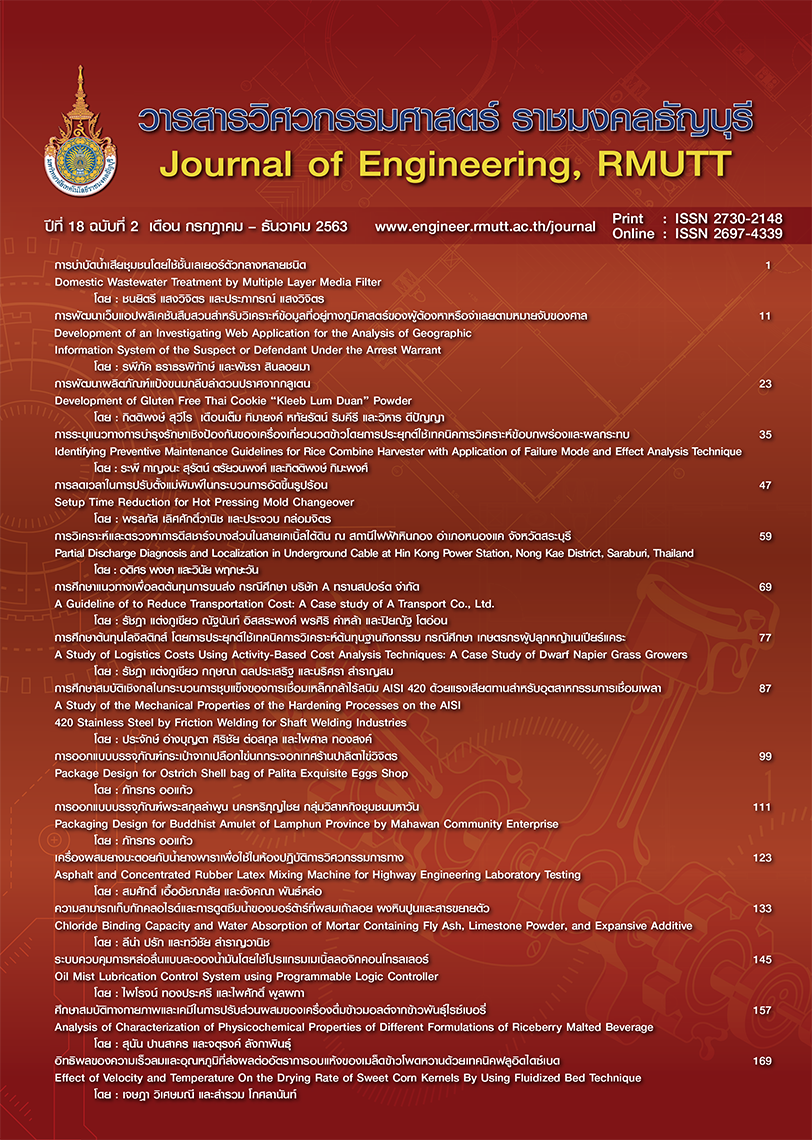ความสามารถเก็บกักคลอไรด์และการดูดซึมน้ำของมอร์ต้าร์ที่ผสมเถ้าลอย ผงหินปูนและสารขยายตัว
##plugins.themes.bootstrap3.article.main##
摘要
งานวิจัยนี้มุ่งศึกษาความสามารถกักเก็บคลอไรด์และการดูดซึมน้ำของมอร์ต้าร์ที่ผสมเถ้าลอย ผงหินปูน และสารขยายตัว โดยใช้ปูนซีเมนต์ปอร์ตแลนด์ประเภทที่ 1 เป็นวัสดุประสานหลัก ใช้อัตราส่วนน้ำต่อวัสดุประสานเท่ากับ 0.40 และ 0.50 แทนที่วัสดุประสานบางส่วนด้วยเถ้าลอยที่ร้อยละ 30 แทนที่วัสดุประสานบางส่วนด้วยผงหินปูนที่ร้อยละ 5 15 และ 25 ตามลำดับ และแทนที่วัสดุประสานบางส่วนด้วยสารขยายตัวที่ร้อยละ 10 ทดสอบการแทรกซึมคลอไรด์แบบแพร่ทั้งหมดที่ระยะเวลาเผชิญคลอไรด์ 91 วัน และทดสอบการดูดซึมน้ำที่ 28 วัน จากผลการศึกษาพบว่า ความสามารถเก็บกักคลอไรด์ของมอร์ต้าร์ผสมเถ้าลอยและมอร์ต้าร์ผสมสารขยายตัวสูงกว่าของมอร์ต้าร์ซีเมนต์ล้วน ในขณะที่ความสามารถเก็บกักคลอไรด์ของมอต้าร์ผสมผงหินปูนต่ำกว่าของมอร์ต้าร์ซีเมนต์ล้วนและเมื่อใช้ผงหินปูนมากขึ้นความสามารถเก็บกักคลอไรด์ของมอร์ต้าร์ลดลง โดยมอร์ต้าร์ผสมเถ้าลอยให้ความสามารถเก็บกักคลอไรด์สูงที่สุด นอกจากนี้ การดูดซึมน้ำของมอร์ต้าร์ผสมเถ้าลอย ผงหินปูน และสารขยายตัวสูงกว่าของมอร์ต้าร์ซีเมนต์ล้วน
##plugins.themes.bootstrap3.article.details##
The manuscript, information, content, picture and so forth which were published on Frontiers in engineering innovation research has been a copyright of this journal only. There is not allow anyone or any organize to duplicate all content or some document for unethical publication.
参考
Sumranwanich T, Tangtermsirikul S. A model for predicting time-dependent chloride binding capacity of cementfly ash cementitious system.Materials and Structures. 2004; 37: 387-96.
Pérez BM, Zibara H, Hooton RD, Thomas MDA. A study of the effect of chloride binding on service life predictions.Cement and Concrete Research.2000;30: 1215-23.
Florea MVA, Brouwers HJH. Modelling of chloride binding related to hydration products in slag-blended cements.Construction and Building Materials.2014; 64: 421-30.
Sumranwanich T, Tangtermsirikul S.Time-dependent chloride binding capacity of various types of cement pastes. ScienceAsia. 2004; 30(2):127-34.
Kim MJ, Kim KB, Ann KY. The influence of C3A content in cement on the chloride transport. Advances in Materials Science and Engineering.2016;2016: 1-8.
Zhu Q, Jiang L, Chen Y, Xu J, Mo L. Effect of chloride salt type on chloride binding behavior of concrete. Construction and Building Materials. 2012;37: 512-7.
Thomas MDA, Hooton RD, Scott A, Zibara H. The effect of supplementary cementitious materials on chloride binding in hardened cement paste.Cement and Concrete Research. 2012;42: 1-7.
Muthulingam S, Rao, BN. Chloride binding and time-dependent surface chloride content models for fly ash concrete.Frontiers of Structural and Civil
Engineering. 2015; 10(1): 112-20.
Cheewaket T, Jaturapitakkul C, Chalee W. Long term performance of chloride binding capacity in fly ash concrete in a marine environment.Construction and Building Materials. 2010; 24(8): 1352-7.
Jena T, Panda KC. Mechanical and durability properties of marine concrete using fly ash and silpozz. Advances in Concrete Construction. 2018; 6(1):47-68.
Zunino F, Boehm–Courjault E, Scrivener K.The impact of calcite impurities in clays containing kaolinite on their reactivity in cement after calcination.Materials and Structures. 2020; 53(44):1-15.
Mehta PK. Studies on blended Portland cements containing Santorin earth.Cement and Concrete Research. 1981;11(4): 507-18.
Mehta PK, Monterio P.J.M. Concrete:Microstructure. Properties and Materials.(3rd Edition), The McGraw-Hill Companies. 2006.
Massazza F. Pozzolanic cements. Cement and Concrete Composites. 1993; 15(4):185-214.
Chindaprasirt P, Jaturapitakkul C, Sinsiri T.Effect of fly ash fineness on microstructure of blended cement paste.Construction and Building Materials.2007; 21(4): 1534-41.
Nguyen C.V, Lambert P, Bui V.N. Effect of locally sourced pozzolan on corrosion resistance of steel in reinforced concrete beams. International Journal of Civil Engineering. 2020; 18: 619-30.
Arttamart S, Sumranwanich T. Compressive strength and chloride penetration resistance of concrete with fly ash,limestone powder and partial replacement of fine aggregate by bottom ash.Journal of Engineering, RMUTT. 2019;17(2): 113-25. (in Thai)
Hussain K, Choktaweekarn P, Saengsoy W,Srichan T, Tangtermsirikul S. Effect of cement types, mineral admixtures, and bottom ash on the curing sensitivity of concrete. International Journal of Minerals, Metallurgy and Materials. 2013;20(1): 94-105.
Deilami S, Aslani F, Elchalakani M. Durability assessment of self-compacting concrete with fly ash. Advances in Concrete Construction. 2017; 19(5):489-99.
Sadrmomtazi A, Tahmouresi B, Amooie M.Permeability and mechanical properties of binary and ternary cementitious mixtures. Advances in Concrete Construction. 2017; 5(5): 423-36.
Naik TR, Singh SS, Hossain MM. Properties of high-performance concrete systems incorporating large amounts of high-lime fly ash. Construction and Building Materials. 1995; 9(4): 195-204.
Praveen Kumar VV, Ravi Prasada D.Influence of supplementary cementitious materials on strength and durability characteristics of concrete.Advances in Concrete Construction.2019; 7(2): 75-85.
Juenger MCG, Siddique R. Recent advances in understanding the role of supplementary cementitious materials in zoncrete. Cement and Concrete Research. 2015; 78(1): 71-80.
Sunil BM, Manjunatha LS, Lolitha R,Subhash CY. Potential use of mine tailings and fly ash in concrete. Advances in Concrete Construction. 2015;3(1):55-69.
Lawrence P, Cyr M, Ringot E. Mineral admixtures in mortars: effect of inert materials on short term hydration.Cement and Concrete Research.2003;33(12): 1939-47.
Lam NT, Sumranwanich T, Krammart P,Yodmalai D, Sahamitmongkol R,Tangtermsirikul S. Durability properties of concrete with expansive additive.Research and Development Journal.2008; 19(4): 8-15.
Liu K, Shui Z, Sun T, Ling G, Li X, Cheng S. Effects of combined expansive agents and supplementary cementitious materials on the mechanical properties,shrinkage and chloride penetration of self-compacting concrete. Construction and Building Materials. 2019; 211: 120-9.
American Society for Testing and Materials.ASTM 1556. Standard test method for determining the apparent chloride diffusion coefficient of cementitious mixtures by bulk diffusion. Annual Book of ASTM Standard. 2004; Vol. 4.02.
American Society for Testing and Materials.ASTM C1152. Standard test method for acid-soluble chloride in mortar and concrete. Annual Book of ASTM Standards. 2004; Vol. 4.02.
American Society for Testing and Materials.ASTM C1218. Standard test method for water-soluble chloride in mortar and concrete. Annual Book of ASTM Standards. 2004; Vol. 4.02.
American society for testing materials.ASTM C1585-04. Standard test method for measurement of rate of absorption of water by hydraulic-cement concrete.Annual Book of ASTM Standards. 2004;Vol. 4.02.

